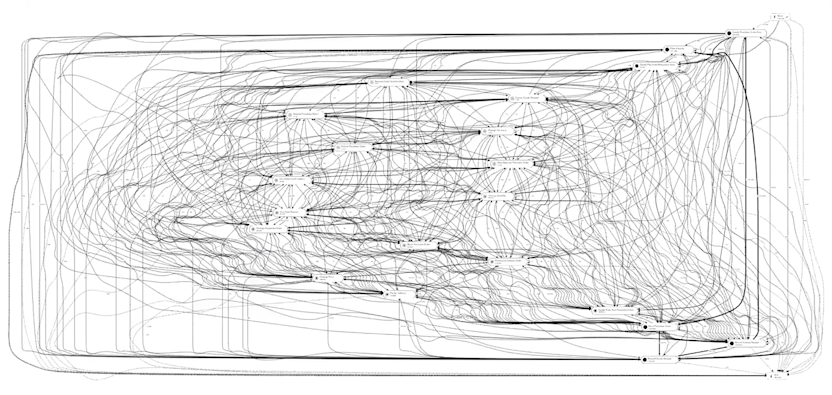
Process Mapping vs. Process Mining: What’s the Difference?
In 1921, the first business case for process mapping was presented to the American Society of Mechanical Engineers. Engineer Frank Bunker Gilbreth, and his wife Lillian, argued that having a visual “record of present conditions” would provide businesses with a valuable indicator of “profitable changes” across Production, Sales, Accounting and Finance. You can hear their original arguments in archive footage of one of their presentations, “The Quest for the One Best Way.” It’s a fascinating watch, and a rare window into the history of business process management.
Except for one thing… strictly speaking, it’s not really history.
That’s because today — over 100 years later — around 65% of businesses are still at the first stage of process maturity, where process mapping is a go-to method for process improvement.
We’ll come on to why this is problematic in a minute. But the good news is, this number is finally decreasing as businesses transition away from process mapping to pursue process mining instead. They’ve seen significantly higher returns being generated across multiple industries from Retail and Life Sciences to Banking and Manufacturing.
So what’s the deal? What exactly is the difference between process mapping and process mining, and is one truly better than the other?
What is process mapping?
The short answer is that it’s exactly what it sounds like — a visual representation of how work happens, often in the form of a process flowchart or value stream map.
It’s helpful for bringing visibility to the individual components of an existing process or workflow, and can help guide basic decision making for core processes, such as in the example below. Most process maps make use of a common language made up of symbols that everyone in the organization can easily understand.

Now for the longer answer on what process mapping is: Although a helpful starting point for process improvement, for most businesses, it’s also a pretty time-consuming and labor-intensive exercise that yields limited results compared to the amount of effort put in. For example, interviews with process owners, managers and other stakeholders are required to get a better understanding of the steps or tasks involved in each process. The outputs of those interviews then get translated into whiteboards and sticky notes (or the digital equivalent of sticky notes…which isn’t much faster).
Even if those initial steps go smoothly, they come with the significant caveat that the opinions gathered at the interview stage may be biased, incomplete or incorrect, and the processes mapped to them will only represent snapshots of reality, rather than what’s unfolding in real time. Plus, by the time the last sticky note hits the wall, an entire process may have changed, given the entire exercise can take months.
After that, there’s the challenge of identifying the pain points within a process map (which, given the above caveats, might not even be an accurate representation of how work is happening), followed by a reordering or replacing of individual tasks or process steps, and finally, a whole new round of map drawing.
Fortunately, business process mapping has evolved somewhat in recent years, allowing for integrations between process mapping software and business process management systems, but this still leaves businesses in a position where they have to manage their complex processes across fragmented technologies, while relying on potentially misleading or incorrect information.
So is process mining just process mapping on steroids?
It’s easy to see why this assumption gets made, as one of the core outputs of process mining software is a set of detailed process maps. But process mapping and process mining couldn’t be more different.
Unlike business process mapping software, process mining technology takes real-world data from time-stamped event logs (and objects, if you’re using object-centric process mining), such as when a purchase order (PO) was created, approved, fulfilled, and dispatched. It then creates an objective and complete view of the processes taking place at scale across your organization, as they’re happening. Machine learning is then applied to create immediate, self-service observations and recommendations, while corrective actions are automated so they can be executed in real time.
In other words, instead of showing you what people think work looks like, process mining shows you what’s really happening beneath the surface. You can think of it as an MRI of your business processes, giving you a living, breathing, moving picture of how your processes actually run, and unearthing high-value improvement opportunities in real time.

Diving deeper, process mining consists of the following five steps:
Data ingestion: During this step, event data is pulled from the information systems that run your business operations, such as your ERP, CRM and SCM, to create an unbiased view of what’s happening across your organization.
Process discovery: This is where process mining technology creates an end-to-end visualization — basically a live, highly detailed process map — of your workflows, revealing insights such as where slightly different process steps were taken in real life, known as “variants,” or which variants caused the process to take longer. It would be fair to say that thisstep alone is a bit like process mapping on steroids...
Process analytics: This is the step where process improvement opportunities are revealed across your organization and quantified across your KPIs. Crucially, this is the step that also separates process mining from workflow process mapping software and basic RPA bots, as it takes process analytics a step further to show you the root causes of missed KPIs.
Process benchmarking: This step gives you the ability to compare process performance across different dimensions, such as how long it takes to complete a process or task in one country versus another, or when using a particular supplier versus others.
Conformance checking: This step reveals commonalities and discrepancies between modeled behavior and observed behavior. In other words, it tells you whether particular tasks or process steps are being skipped, prolonged or executed in the wrong order.
It’s a lot to take in, but hopefully the takeaway is clear: Process mining isn’t remotely like process mapping on steroids. It’s an entirely different beast that facilitates continuous improvement, generating a significantly higher ROI.
All of this adds context to Gartner’s prediction that by 2025, 80% of organizations driven by the expectations of cost reduction and automation-derived enhanced process efficiency will embed process mining capabilities in at least 10% of their business operations.
Is process mapping easier to achieve than process mining?
The answer to this question may seem like an obvious “yes” as it’s undoubtedly easier to draw a process flowchart or value stream map than to complete all the above steps. But that’s a false economy — especially if you end up with an inaccurate, out-of-date process map with no meaningful actions automated as a result, or if you’re spending millions with consultants to do it.
Plus, if you conduct a thorough process mining vendor evaluation, you should be able to find one who can provide all of the above process mining capabilities for you. For example, if you decide to take an platform approach to process mining (which is where process mining is embedded into a wider platform to continuously manage and orchestrate your business processes), your process mining platform would automatically create objective process maps for you, while running all the other steps in tandem.
Process mapping vs process mining: Which is the best solution for you?
Ultimately, it’s up to you and your stakeholders whether process mapping or process mining makes the most sense for your business right now. Diving deeper into the specific use cases you’re trying to solve is probably the best next step for figuring that out.
But hopefully one thing is clear: Process mapping and process mining couldn’t be more different. Traditional process mapping was a longstanding cornerstone of business process management (100 years isn’t a bad run…), and it has earned its place in BPM history. But if you’re looking for a process improvement solution that’ll get your business working faster and more effectively both now and in the future, process mining could be for you.



